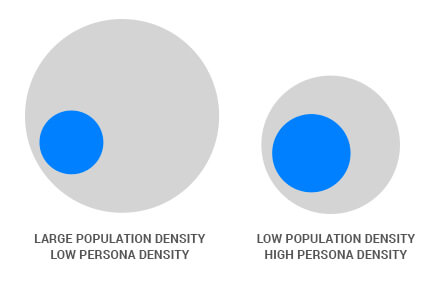The top 5 commercial real estate mistakes with demographics
Featured in RealtyBizNews
As a real estate broker, knowing when to use data is tough. How much should you rely on what the demographics tell you? Or how much weight should you place on the painfully obvious vagrancy problem when you drive through the trade area?

What it really comes down to at the end of the day is a factor of trust. Do you trust your data? Most realtors don’t, for a variety of reasons.
First off, it’s them and not the computer algorithm whose job is on the line. Most brokers take serious pride in well-placed sites – they’re a badge of honor. A dog site that gets shuttered on the other hand? That’s a mark of shame which weighs upon your reputation and future success, and when it’s all said and done you can’t point fingers at what the data said. Nobody’s going to fire your laptop.
Secondly, most brokers don’t understand their data well enough to trust it. They make common calculation errors and when the data doesn’t line up with their intuition, they dismiss the data like it’s a bumbling but well-intentioned birddog who can’t be trusted with these sorts of things.
Both of these reasons for mistrust are extremely shortsighted, however, and leave the broker exposed to the dangers of emotional decision-making. Ignoring the demographics simply because there’s some risk is like closing your eyes during a driving test so that you can focus on listening to the instructor. Don’t drive blind! You need to take in everything and allow the data to elevate your decision making from an art to a science.
To do this, you need to understand how to use the data and almost more importantly, how not to use it. Today, we’ll start with demographics.
-
Using old (let’s be honest, census) data
As we’re all aware, there are a lot of people on this planet and a whopping 319 million of them reside within the United States. Keeping tabs on them all is tough, but we’ve gotten considerably better at it over the years. With the ubiquity of smartphones and the plummeting cost of sensors and data storage, people self-report their locations, desires, interests, heck – they even share pictures of the meals that they eat.
In a way, we’ve all come to be employees of a much larger, much more advanced 21st century super-census.
To rely on good old fashioned census data this year is to do a terrible disservice to yourself and your clients. And we get it, we’ve all bit our lip as we reluctantly slipped 2009 census data into a 2016 presentation because it was the newest available. But what does an excellent report based off old data lead to? An amazing site decision that comes 7 years too late.
Seven years is a long time. That’s enough time for you to found Uber (now valued at $66 billion) and still take a few months off to go traveling.
What can you do differently then? Get your demographics data from a site-selection software that collects it all in real-time. -
Neglecting psychographics
Psychographics seem like a small and unimportant thing, and you’ll hear them derided and questioned in both the real estate and marketing worlds as a pseudo-metric, but they can matter, big time. Take for example, two trade areas of roughly 250,000 people with average incomes of $45,000 and identical ages and levels of education. Demographically speaking, they are the same.
Which would you choose to place your client’s fast-casual health food restaurant concept? Either right? They’re the same. Except that one is in San Francisco, California and the other is in Mobile, Alabama.
Now which site do you feel more strongly about? That’s because belief systems, lifestyles, habits, values, and opinions matter, and you’re using psychographics to make decisions subconsciously even when you think you aren’t.
People consume and patronize places that they know, love, and like, and ignoring this will keep your demographics from showing the complete picture.
-
Thinking that high density is everything
Would you rather have a massive customer base with a small ideal-customer persona density or a small target market with a high ideal customer density? When in doubt, most folks choose the former, but the latter is a much savvier move.
Consider this chart:

Just as getting thousands of responses from bogus real estate leads can only waste your time, so can a tremendous amount of poorly-targeted foot traffic give you and your client the dangerous illusion of success.
Use your demographic studies to zero-in on specific profiles of customers and where those clients are amassed.
-
Shooting for just one target audience
Many brands can fall victim to tunnel vision in trying to target the demographic criteria for only their most ideal customer personas. This causes leads them to force their brokers down a very specific path that neglects the fact that when it comes to customers, more options is better. What you really want to explore are sites with lots of overlapping target audiences – if it’s a restaurant concept, you want to be at the center of the Venn Diagram for breakfast, lunch, and dinner patrons, young, middle-aged, and aging.
Is the client giving you kickback? This is your chance to do a little challenger sale education with your prospects and help them think about the broader ecosystem of possibilities where many more target audiences overlap.
-
Using only demographics
This might be the biggest one of all. Demographics are great, but are they a complete picture? Never. That’s why you should be nimble about incorporating as much as data as you possibly can into a model that takes into account things like points of interest, weather, home values, traffic and transportation, and sales.
If you’re having trouble visualizing all of these factors in place, you’re not alone. Plotting it all on a Google Maps just isn’t possible and if you’re not a GIS expert with a PHD in statistics, you’re going to want some help. Luckily, modern location intelligence software helps brokers model everything simply on one screen.
Tactical, Practical, and Demographical
When you get better at using data, you learn to trust it, and it gives you an edge that few other brokers have. Your demographic data is a major underpinning of your decision making but it isn’t infallible – it’s one piece of a many-sided decision-making process that will only improve when you learn to understand and trust all of your information!
Recommended Posts

